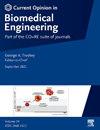Beyond static models: Mechanically dynamic matrices reveal new insights into cancer and fibrosis progression
IF 4.2
3区 工程技术
Q2 ENGINEERING, BIOMEDICAL
引用次数: 0
Abstract
The dynamic mechanical nature of extracellular matrices (ECMs) is crucial for the mechanosensitive regulation of cell fate. This is evident in pathological conditions such as cancer and fibrosis, which are characterised by highly fibrotic tissue developing over time. This fibrotic progression not only alters tissue mechanics, but also coincides with the reprogramming of resident cells, promoting their differentiation into aberrant phenotypes and increasing drug resistance. Hydrogels, with their tuneable mechanical and biochemical properties, emerge as powerful ECM mimetics to model and study these abnormal, mechanically-driven cell differentiation phenomena. In this review, after establishing how conventional, mechanically static hydrogels contribute to our understanding of the role of altered mechanosensing in cell differentiation during cancer and fibrosis, we explore the research opportunities given by advanced dynamic matrices. Models employing hydrogels that are fast relaxing, plastic or even with temporally switchable mechanics reveal the otherwise hidden role of time-dependent phenomena during disease development.
超越静态模型:机械动态矩阵揭示了癌症和纤维化进展的新见解
细胞外基质(ecm)的动态力学性质对细胞命运的机械敏感调节至关重要。这在癌症和纤维化等病理条件下是明显的,其特征是随着时间的推移高度纤维化组织的发展。这种纤维化进展不仅改变了组织力学,而且与常驻细胞的重编程相吻合,促进其分化为异常表型并增加耐药性。水凝胶具有可调节的机械和生化特性,成为强大的ECM模拟物,可以模拟和研究这些异常的、机械驱动的细胞分化现象。在这篇综述中,在确定了传统的机械静态水凝胶如何有助于我们理解在癌症和纤维化期间改变的机械传感在细胞分化中的作用之后,我们探索了先进的动态基质提供的研究机会。采用快速放松、可塑或甚至具有时间可切换力学的水凝胶的模型揭示了疾病发展过程中时间依赖现象的隐藏作用。
本文章由计算机程序翻译,如有差异,请以英文原文为准。
求助全文
约1分钟内获得全文
求助全文
来源期刊

Current Opinion in Biomedical Engineering
Medicine-Medicine (miscellaneous)
CiteScore
8.60
自引率
2.60%
发文量
59
 求助内容:
求助内容: 应助结果提醒方式:
应助结果提醒方式:


